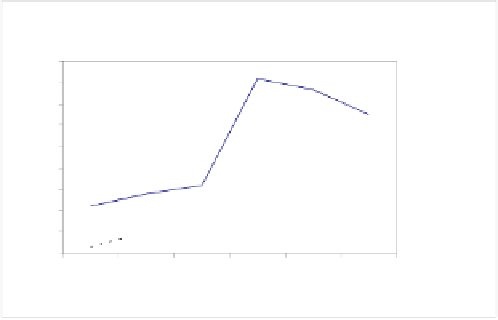Information Technology Reference
In-Depth Information
from the endocarp towards the outer mesocarp, the same being suggested on the base of
fruit softening (Chan et al., 1981; Lazan et al., 1989) The inner mesocarp tissue is softer
and its firmness decreases more rapidly during ripening than that of the outer mesocarp
tissue. The levels of PE activity increase gradually with maturation (fig.1). The
pectinmethylesterase activity increases differentially from the outer mesocarp to the inner
mesocarp along ripening (fig.1). These values are similar for 7 days-ripened fruits, which
corresponds to 70% ripening. After that ripening stage there are no significant differences
between PME in inner and outer mesocarp and the PME activity is reduced of about 10%.
The reduction of activity does not parallel the total protein values that increase with
ripening. The highest values of PME activity, have been found for the same ripening stage
as Polygalacturonase activity is highest (data not shown) which is in agreement with results
from other authors according which PME, an enzyme that catalyses demethylation of the C
6
carboxyl group of galacturonosyl residues, may play an important role in determining the
extent to which pectin is accessible to degradation by polygalacturonase (Koch et al.,
1989). According to Harriman et al. (1991) during tomato ripening the levels of PME
protein continue to increase beyond the turning stage while the PME activity begins to
decline. As the fruit ripens, pectin solubility and depolymerisation increase (Lazan et al.,
1995). According to these authors tissue softening is more closely related to changes in E-
galactosidase activity than to PG or PME activity. Similar results have been obtained by
Harrimann et al. (1991) for tomato PME activity. Differential ripening has also been
reported for papaya ACC activity by Chan (1991). In
Persea americana
fruits, PME
decline from its maximum at the time of picking to a low level early in the climateric
(Awad and Young, 1979).
PE activity in inner and outer mesocarp
90
80
70
60
50
Outer
Inner
40
30
20
10
0
0
2
4
6
8
10
12
Ripening stages (Days)
Figure 1.
Changes in PME activity along ripening of papaya fruit mesocarp.
Dot line represents the activity at the inner mesocarp and the continuous line at
the outer mesocarp.
Fruits at maturation stages (1, 3, 5, 7, 9 and 11 days respectively) prepared for
sampling and RNA extraction produced yields of the purified RNA in the range of 300-450
Pg RNA per g/fw of tissue of ripening fruit and 150- 200 mg per g/fw of non ripe fruit
tissue. In all cases A
260
/A
230
values were about 1.9-2.0, which indicates high purity of the
RNA preparation. The quality of RNA was evaluated by RT-PCR applications, Northern
Blotting analysis, mRNA isolation and cDNA library construction.
The construction of cDNA libraries is a basic step in most molecular biological
techniques.
































